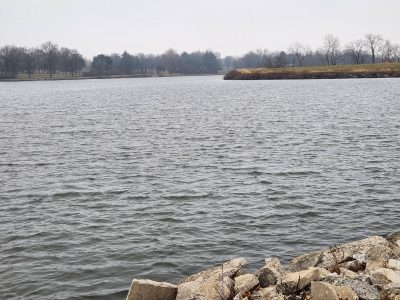The City of Jacksonville is going to have a major engineering project involving the local watershed in the near future.
Lake Mauvaisterre was dredged back in 2015 to allow for more storage and to remove several tons of sediment that had built up. The city has been active with the Illinois EPA’s 319 grant program that assists with upkeep and preservation of local watersheds. Jamie Headen, Engineer of Benton & Associates, says that one solution to keep sediment from running off from the fields and into the lake has been proposed in the past: “A recommendation has been to consider an in-lake sediment dam, which would then trap sediments if we can’t keep them in the farm fields…maybe trap those in an area where we can get to them, and then, improve water quality at the intake, which is on the north side of the lake. A part of that then is also to reduce the nutrient and sediment loading, but the nutrients nitrogen, phosphorous and the other things that we’re trying to do to also improve water quality.”
The city received a $175,000 50-50 matching grant 3 years ago to continue work on water quality at Lake Mauvaisterre. Headen says that the sediment problem dates back to 1921 with the lake, with the east side now seeing the heaviest amount of settling. Headen says their some goals and limitations to the work that can be done at Lake Mauvaisterre: “Some of the product goals is to increase sediment trapping, and so, we’re trying to catch the sediment where we can get to them in the future and like we did with the dredging project, maybe we can get them to where we can handle them a little more frequently so there is less of a time period between when we need to dredge, and to make them more cost effective to get out into the dredge disposal site. Improve the water quality, of course, and protect the water supply. And, then, trying to make sure that the money that we’re spending upstream is not being wasted downstream. One limitation…and anything we do in the lake, we want to make sure we don’t increase the flood level of the area. If we are going to make investments in some portions of the lake, we are also trying to see if there is opportunities for recreational chances there. Those different things that we can do might make [Jacksonville] more grant-eligible as we go forward.”
Adam Fox, Engineer and Environmental specialist, says that the city has several options with the lake from doing nothing, installing a sedimentary dam in the lake on the east end, or doing a multi-million dollar on-lake dredging operation. Fox says that the working group of the city’s Parks & Lakes Department along with members of the City Council have selected a more recreation-friendly option: “The in-lake dam with pedestrian access, and then, bridges that could be constructed across there at the openings. There would be openings there to allow the flow of water to go through with a Weir wall and some sort of a set elevation to hold back the flow of water or slow it down to come through there. Again, it would be restricting access to the eastern portion of the lake, but that may not be a negative thing. It could be an area, if the city would so choose, to be a designated canoe/kayak portion of the lake, so [the dams] do serve a purpose. They function well. This one would have the added benefit of additional recreational opportunities out there with the Bark Park not far from there, and it would utilize the previously dredged areas to trap the sediments. Then, it would provide location where the city would be able to access that for future dredging and maintenance to get those sediments back out of the lake.”
The cost estimate on the in-lake dam with the pedestrian access was at $2.8 million. Fox says a host of agencies will have to be met with to ensure that the site plan and design meet regulations and do not cross the threshold of any restrictions.
Jamie Headen says that depending upon the permitting process, the project would come back before the City Council possibly within a year’s time. He says at that point, public hearing would need to be scheduled and more funding would have to be secured.




